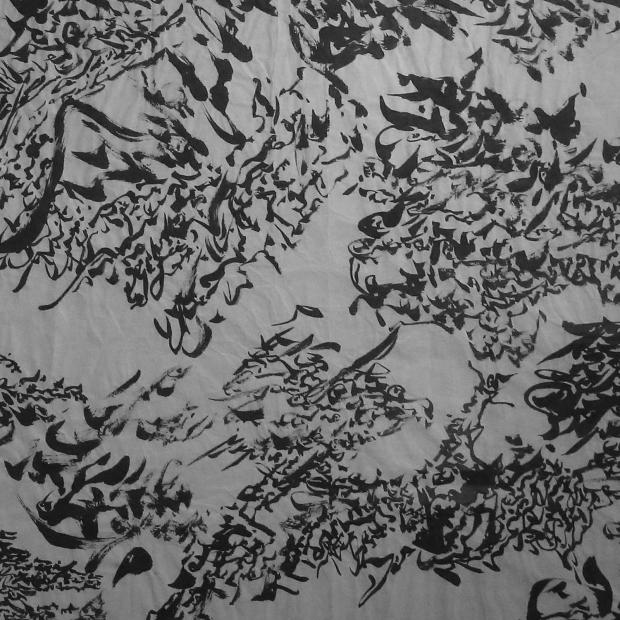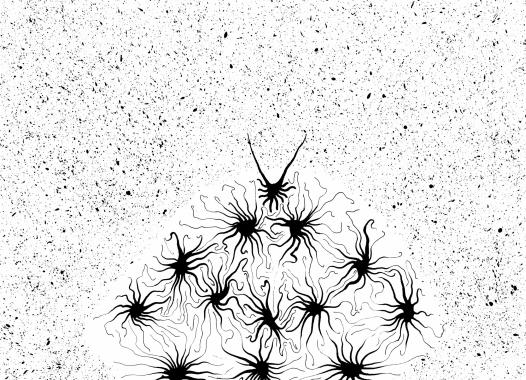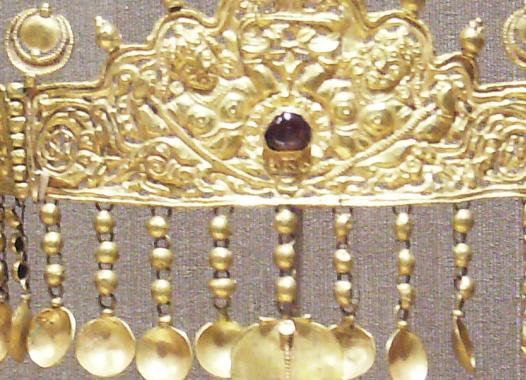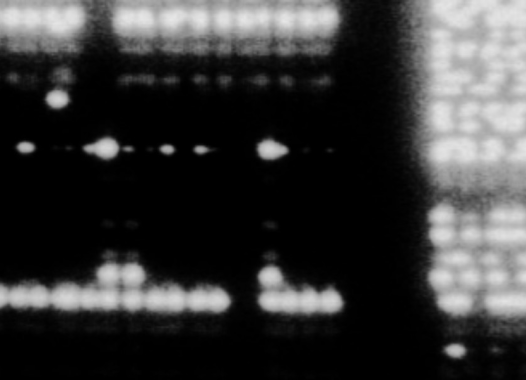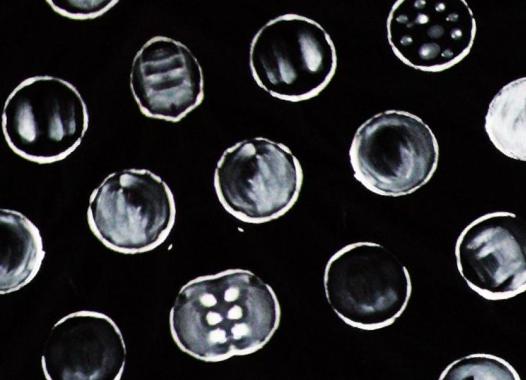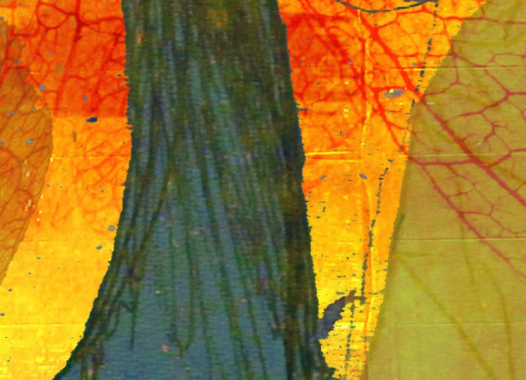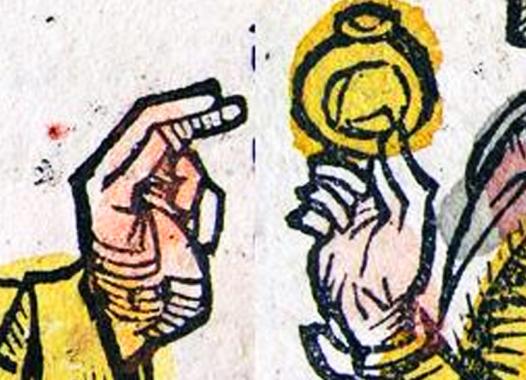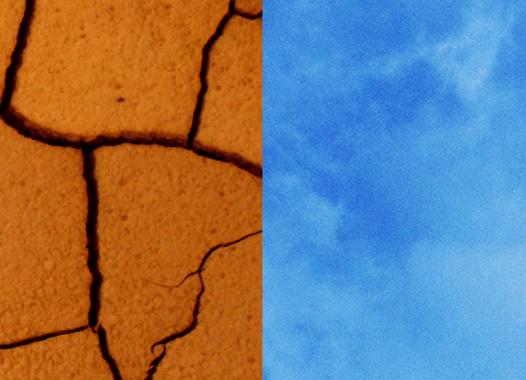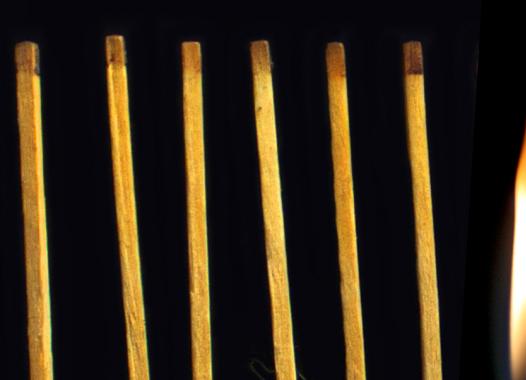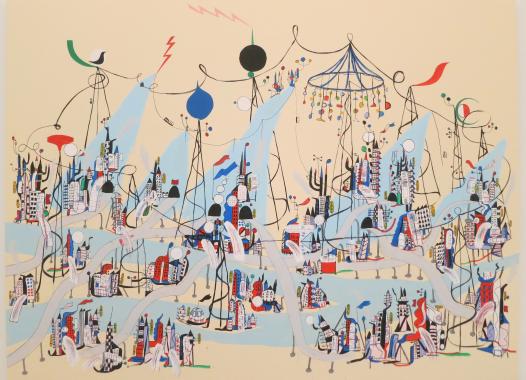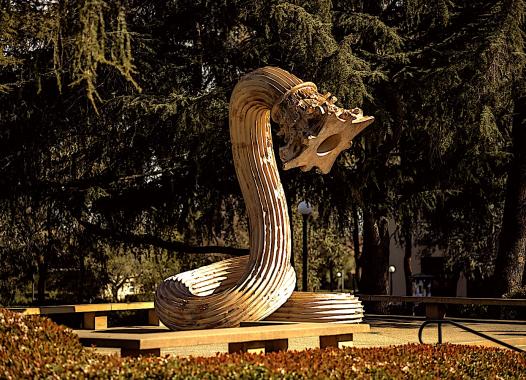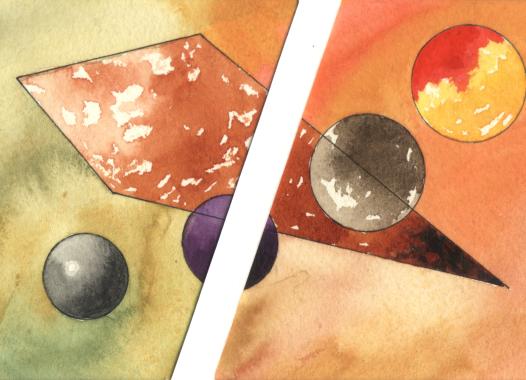
1 An early moment in my life was at a wedding that I attended in a Dubai suburb when I was four or five years old. I could, as a child, slip back and forth between the women’s wedding celebration and the men’s wedding celebration, as both were hosted on the same street and at the same time. At some point during the night, word spread among us children that a khanith was at the men’s celebration. We were curious to see. One kid explained to the rest that the khanith was half-man, half-woman.*
We saw a man, a member of the music troupe, dressed in a white and tight-fitting kandorah (an ankle-length garment worn in the region) and on his head the ghutrah (a white headdress worn most often in formal settings) perfected and knotted into his ʿugal (a black cord worn on the ghutrah to keep it in place). The makeup on his face was detailed, a very pale foundation with a distinctly pink blush to the cheeks and a kuhl (a dark eyeliner) lining his eyes. I do not remember how long I stayed there taking in the sight, nor do I remember whether the word khanith was used in any pejorative sense.
2
Early enough in my adolescence, the internet became a social space safe enough for self-understanding and for rejecting the heteronormative possibilities of my future. Most of these online spaces were in English by default; occasionally there might be a space in Arabic, but that did not become common until later. I found myself living between the languages I spoke, at times preferring to use English, and at other times Arabic. At some point, I found an online support group for LGBT teenagers mostly in the United States, but there were members from Asunción, Paraguay and Sydney, Australia. I became accustomed to referring to myself using English terminology common in LGBT society. At some point, as I began to participate in online translation work, I tried to find people like me who described themselves in Arabic terminology, and it took a while to do so. Eventually I found a chatroom under the channel name #makhanith (in the Arabic script). There were about thirty or forty regular users. Most of them were from the Gulf Arab states. And many were there to cruise for sex, but I found it difficult to find folks in Dubai specifically, so I ended up spending most of my time there having random conversation with others. These conversations were almost exclusively in Arabic, and that is how I learned the LGBT community’s terminologies used in my variety of Arabic. These online spaces became an important part of my identity, and the name of the chatroom lent itself to that. Indeed, often when speaking in English I found myself using the usual Western terminology expected by English speakers, while in Arabic I often used khanith in self-reference as it served the purpose of signaling to Arabic speakers who rejected heteronormative possibilities who I was and how we are in relation to each other.
As I entered my early adulthood, I attended dinner gatherings where community members relaxed from the usual self-guardedness they took on when in mainstream society. These spaces were often bilingual, with Arabic and English spoken as the common languages of the gatherers. The pronouns would vary between the languages: in English, it was rare that the men used feminine pronouns among themselves. However, the Arabic speakers used the feminine pronouns to refer to each other. I often felt uneasy about this variety of pronoun use because the question of pronouns was a constant reminder that our bodies and the way we inhabited them were constantly surveilled in the spaces beyond that gathering and policed for any form of transgression.
3
I took on a research project to produce a critical edition and annotated translation of a work of law from the Shafiʿi school of jurisprudence written by ʿAbd al-Rahim al-Isnawi. It was titled Idah al-mushkil fi ahkam al-khuntha al-mushkil [Clarification of the Problem in the Rules of the Uncertain Khuntha].[1] As I began gathering copies of a number of extant manuscripts of the work, a librarian at Jumʿa Al Majid Center for Culture and Heritage, a Dubai-based manuscript library, assisted me in locating and gaining access to the manuscripts. He hesitated in enunciating the word khuntha when reading the title of the book on file the first time, and the second time he avoided it entirely.
I was initially unsure why he held his breath the first time half-way through the word, but months later I realized why: khuntha and khanith are related. The relationship is there because of the etymology, and most of the related words from the root carry a social stigma. Because the words are often used pejoratively, and because the embodiment of what these words refer to is stigmatized by society, the librarian understood immediately that this word too may cause or bring offense.
* * *
The Khaʾ-Nun-Thaʾ Triad Examined Closely
The cultural history of the Arabian Peninsula, in both written and oral traditions, is rich in representations of people who inhabit their bodies in ways that are considered to be transgressive of the usual expectations placed upon them by mainstream society. A khuntha, a mukhannath, and a khanith would inhabit their bodies in the in-betweens and margins of gender, sex, and sexuality, in ways that may be understood at times as non-heteronormative and at other times as non-cisnormative.[2] These terms are associated with a set of identities that today would be considered to be a member of the Society of Mim (in Arabic: Mujtamaʿ al-Mim, the Arabic equivalent of the LGBT acronym, where Mim is the first letter of all the words in the acronym).
Each of these terms have their own specific linguistic associations, but they share a common etymological root: khaʾ-nun-thaʾ. The linguistic relationship between the terms and the rest of the Arabic language is paralleled by an often-conflictual relationship between those who identify as khuntha, mukhannath, or khanith, and their social environment. These three terms should be considered together, rather than in isolation, so that we may become able to understand this relationship with their social environment.
The khanith (plural: makhanith and khunuth) is a term used colloquially in Arabic-speaking coastal societies, most commonly in the current states of United Arab Emirates and Oman. It refers to a marginal identity that transgresses heteronormative and cisnormative pressures in the modern Gulf Arab nation-state. However, the identity itself did not arise as a strictly modern identity, but is instead the current development of an earlier identity described in the classical Arabic literature (Rowson, 1991, p. 693), the mukhannath (plural: mukhannathun). The mukhannath is the term most often invoked when scholars of Islamic studies discuss male homosexuality and male effeminacy. Another identity described in classical Arabic literature is the khuntha (plural: khunatha). This identity often arises in legal treatises addressing inheritance rules, because the question of the sex of the khuntha arises in order to calculate each heir’s inheritance. The khuntha, unlike the khanith and the mukhannath, is recognized by their body, rather than their inhabitation of the body, which is recognized as having both a vulva and a penis (Sanders, 1991, p. 77; Almarri, 2016, p. 580).
I began this paper with a personal narrative so that I may reflect on the relationship between the three terms salient in those memories. I employ the narrative here not alone, but rather alongside analysis of linguistic and archival material. This autoethnographic text is not simply a narrative of self-representation but rather it is an engagement with, a reflection on, and a critique of representations others have made of their community (Denzin, 1997; Pratt, 1991). The narrative and the analysis that follows are written in dialogue with works by anthropologists, scholars of Islamic studies, and Islamic jurists.
I first turn to Mary Louise Pratt’s (1991) example of an autoethnographic text. She describes in her essay that Guamán Poma wrote the Nueva Corónica describing the Spanish colonization of the Andes, noting that he addressed it to the metropolitan audience in Spain, along with his own community in the Andes (p. 35). Pratt (1991) shows us how the chronicle is an autoethnographic text which responds with colonial representations of Poma’s community, critiques the destructive colonization of the Andes, while also engaging with Poma’s own community and the possibility of a better future. It informs the purposes that underline this paper, as I address this paper similarly to two communities: first, to the community of scholars, and secondly, to Mujtamaʿ al-Mim with whom I share most affinity.
I aim to explore in what follows the three terms listed above, and their associated identities, along with their linguistic characteristics of the terms and their literary uses. We know through the use of these terms that there were people who were identified with one or more of these terms throughout the cultural history of Islamic and Arabic societies. I also aim to reflect on my experiences as a tool to think about the identities and their relationships to one another. I will now turn to each of the three khaʾ-nun-thaʾ terms and identities in the following sections.
The khanith was first documented in anthropological scholarship by Unni Wikan (1977) during ethnographic fieldwork in Sohar, Oman. Wikan’s study proved to be controversial among anthropologists, triggering a heated debate about definitions and methodology. Just like me, Wikan’s first encounter with a khanith was at a wedding. However, unlike me, her encounter did not bring about any form of self-identification, but rather the khanith for Wikan was an object of her scholarly gaze. Wikan (1977) identified the khanith as a transsexual, defining transsexualism as “a socially acknowledged role pattern whereby a person acts and is classified as if he/she were a person of the opposite sex for a number of crucial purposes” (p. 304), a definition she abandoned later when other anthropologists raised objections about her article (Shepherd, Feuerstein, Al-Marzooq, and Wikan, 1978, p. 670). Wikan (1977) goes to great length to describe the choice to identify the makhanith she encounters as transsexuals as opposed to homosexuals because they are “anatomically male but act effeminately and move freely amongst women behind purdah” (p. 306). Wikan uses purdah here to refer to the physical segregation of sexes, though the term itself is primarily used for South Asian contexts.
There is much to fault in Wikan’s (1977) article, as many scholars have discussed at length (see Brain, 1978; Carrier, 1980; Murray, 1997; Shepherd, 1978; Shepherd et al., 1978; Wikan, 1978). For example, Wikan (1977) seems to suggest that khanith do not enter spaces that are exclusive to men at all. However, both Shepherd et al. (1978, p. 664) and Murray (1997, p. 246) point out that the khanith is legally a male and therefore can move in spaces exclusive to men as easily as it is for them to move into spaces exclusive to women.
The most important critique of Wikan (1977) during the ensuing controversy charged her with committing epistemic violence by interpreting an Arabic term (khanith) with Eurocentric categories (transsexual and homosexual), which imposes strict binaries for sex and sexual behavior. This problem eventually became apparent to Wikan who wrote in a later reflection that the choice of terms resulted in much confusion (Shepherd et al., 1978, p. 670). Wikan (1977) erred in applying a strict heterosexist understanding on the khanith’s sexuality when she discussed pairings involving a khanith. In two instances, she allowed her prejudices to mark her analysis: the first instance was when she observed to her Omani friends upon discussing a khanith’s consummation of marriage to a woman that “the poor woman who has such a ‘woman’ for a husband—she could not possibly respect him” (p. 309); the second instance was when she writes that “there is nothing in the Omani transsexual’s behaviour which is represented as pure or beautiful; and he does not seek sexual release for himself” (p. 310). It becomes difficult to read Wikan’s article seriously without observing serious prejudices affecting the analysis. There is no indication in Wikan’s article that she approached any khanith in the town where she conducted the fieldwork to interview them, as she relies mostly on her female friends. There is no indication, either, that Wikan knows about the mukhannath or the khuntha and this, too, may have adversely affected the analysis.
The khanith is, of course, not the first term to get deployed inappropriately by Western academic scholarship. As Stryker and Currah (2014, p. 7-8) observed, Western academics have a long history of epistemic violence, particularly around gender identity and sexual orientation. Western explanations of terms like berdache and manu often oversimplify and decontextualize nuanced and complex cultural understandings of gender identity and sexuality in order to make it possible for Western subjects to look East and see themselves inscribed there (see also, Garber, 1991, p. 244-245).
Shapiro (1991) points out how a careful examination would offer “interesting contrasts with respect to the relationship between sexual orientation and gender identity” between the Euro-American transgender and transsexual and the Omani khanith communities (p. 265). However, this contrasting study can only begin after the categories in question are examined carefully. Both Murray (1997) and Shepherd (1978) reinterpret the khanith’s social practices in light of regional practices across the coasts of the Indian Ocean. Shepherd (1978) compares the khanith in Sohar to the mshoga in Mombasa (p. 133), suggesting that the khanith may represent a situation far more complex than a simple gender dichotomy. Shepherd suggests the possibility of a class dimension in relation to the khanith’s relationship to the men in the community, where poverty and social class may lead them into sex work. Wikan’s (1978) unsatisfying response to this criticism seemed bewildering: she rejects Shepherd’s mshoga interpretation as “hear-say evidence” (p. 474). Murray, on the other hand, suggests that there may be “some convergence of cultural conceptions” of the hijra in Gwadar and the khanith in Sohar (1997, p. 245). This gets taken up by Makia (2016), who observed that the khanith as an informal yet politicized identity “can move between genders and return to the position of male elder” (para. 21). This interpretation places it within a spectrum of non-cisgender bodies found in Pakistan (hijra), the Kenyan coast (mshoga), and Iran (dojense).
The identity of the khanith has without any doubt gone through shifts since Unni Wikan ended her fieldwork. Social life and education have undergone changes in both the United Arab Emirates and Oman, making it easy for the youth in the region to transculturate Western social attitudes.
I will focus here on Dubai, UAE as an example for education in the region: since the late 1980s the United Arab Emirates has undergone an expansion of private education. This made it easy for people to enroll their children in any of the 16 available educational curricula (Knowledge and Human Development Authority of the Government of Dubai, 2017, p. 2). Private schools would advertise their curricula when enrolling students. The language of instruction would be implied with the curricula: Arabic for the UAE’s national curriculum, and English for most other curricula (such as the UK, India, US, International Baccalaureate, and SABIS curricula). This made it common for middle class families to have children who became bilingually proficient in English (as a school language) and their home language (in my case, this was Arabic).
My two languages gave me access to using the internet to seek out resources for LGBT youth, eventually finding the online support group. Code-switching between the two languages became a foundation for me to embody the identities I knew in Arabic and the identities I knew in English. At times, such as the dinner gatherings, I embodied the identities just as easily as I code-switched between English and Arabic.
For many years before I began to take questions of translation seriously, I assumed khanith was just another word. However, as I returned to it as a translator and scholar of translation, the question of its relationships to other related terms became apparent and important. This question suggested that there is more to it than just another word but rather that it is a part of a series of entangled networks of meaning.
The identity of the khuntha seemed to be represented mostly in legal literature (Almarri, 2016; Ragab, 2015; Sanders, 1991). This term is often translated as hermaphrodite, or intersex person; however, such translation glosses over the difference of the khuntha being used to refer to ambiguity of genitalia on the body’s surface as opposed to ambiguity internal to the body (Almarri, 2016, pp. 580-581). These translations also gloss over the relationship the khuntha has with the rest of the khaʾ-nun-thaʾ terms.
The few extant narratives of the khuntha were restricted to Islamic-era historiographic literature of pre-Islamic Arabian legends. The 18th century scholar al-Zabidi reproduced in his Taj al-ʿarus (1993, vol. 3, p. 207) a poem referring to a horse named “Khuntha.” This horse belonged to ʿAmr bin ʿAmr who was a warrior in the battle of Yawm Jabalah, circa mid-sixth century CE. Another pre-Islamic narrative was reproduced by the 14th century historian Ibn Kathir in his al-Bidayah w-al-nihayah (2010, p. 486-487). It describes the dilemma the Arabian leader ʿAmir bin al-Dharib al-ʿUdwani had when presiding over an inheritance dispute among brothers and their khuntha sibling. His servant who cared for his herd of goats named Sukhaylah suggested a solution. She told him she would solve the problem of “gendering” them by observing their urination. With the caveat of this narrative being reproduced in the Islamic era, it could indicate that the urinary orifice rule, which was described by Sanders (1991) and by Almarri (2016), could be a development of Arabian custom. This rule became a part of the process of “gendering” a khuntha whereby the judge observes whether one urinates from a urinary orifice in the penis or in the vulva in order to declare a khuntha a man or a woman by law. This rule was adopted with slight variations into Islamic law, as observed in Fatimid legal manuals (Almarri, 2016) and Hanafi legal manuals (Sanders, 1991).
The Shafiʿi legal manual written by al-Isnawi compiles existing rules on the khuntha as developed by jurists within the Shafiʿi school of jurisprudence and expands upon them. The urinary orifice rule was maintained by al-Isnawi in his work. The manual is comprehensive enough to consist of two major sections: the first section defines “khuntha” and describes the process of “gendering” a khuntha, while the second section contains the bulk of the rules placed upon khuntha once they are identified. The word khuntha itself has unusual linguistic characteristics, which al-Isnawi clarifies in the first section. The word’s root (khaʾ-nun-thaʾ) signifies the mixing of forms. The khuntha is one such mixing, seen by al-Isnawi and other jurists to indicate the mixing of the male and female genital structures in the same body. The word ends with an alif maqsurah, which is one of the ways Arabic morphology marks the grammatical feminine. However, the word inverts gender agreement rules, requiring masculine pronouns and adjectives and masculine verb conjugations, without regard for the results of the legal “gendering” process (Al-Isnawi, MSS Peterman II 673, p. 57). [3] This marks the khuntha as not cisgender, even in the language (cf. Aultman, 2014; Lennon & Mistler, 2014). It demands the use of a particular gender pronoun that is not necessarily obvious to the mainstream reader upon first encounter. It becomes important that al-Isnawi respects this gender pronoun dis-agreement by maintaining its use throughout the work, as did the manuscript copyists themselves.
Unlike the term khanith, the term khuntha seems to lack pejorative use within the legal genre. Its semantic proximity to khanith made it pejorative by association. This was the probable reason for the librarian to have held his breath when reading the title of al-Isnawi’s book. The mukhannath, like khanith, carries a pejorative meaning; however, it does not seem to be as transgressive as khanith came to be in the twentieth and twenty-first centuries.
El-Rouayheb (2005) surveys how mukhannath as a term was used by scholars as a flag for homosexuality in a way that erased the distinctions that Arab-Islamic culture made for the various behaviors associated with homosexuality. These distinctions marked the differences between insertive/active and receptive/passive partners in anal sex, and the distinctions between infatuation and sexual lust.
Afsaneh Najmabadi (2005) documents how nineteenth century Iranian culture used this term to refer to adult men who wanted to be an object of desire for other adult men by making themselves look like young beardless men (p. 16). Samar Habib (2007) points out in her close reading of al-Raghib al-Asfahani’s depiction of the mukhannathun that the term came to signify a number of “(sometimes unrelated) sexual and gender orientations” (p. 49). These could be effeminate men, but also sexual bottoms, even “the perfect faggot” (p. 49).
In his study of anecdotal literature of Medina’s community of mukhannathun, Everett Rowson (1991) writes that the lexicographers defined the mukhannath as an effeminate man “without distinction between involuntary and voluntary behavior,” and noted that the term “does not indicate transvestism” (p. 673). He uses the Sunni Hadith canons and Kitab al-Aghani to show how the mukhannathun were “an identifiable group of men who publicly adopted feminine adornment, at least with regard to the use of henna, and probably in clothing and jewelry” (p. 675). Rowson (1991) also shows that the mukhannathun were not necessarily known for engaging in sodomy, where some were known to be married to women who have borne them children (p. 679 and 681).
The transgressive use of gender pronouns was a feature of how the mukhannathun community used the Arabic language. They would use feminine gender pronoun when talking to each other. Rowson (1991, p. 689) describes an incident where Mukhkha called on Khaytham bin ʿIrak using feminine pronouns.[4] Mukhkha used feminine pronouns because he believed that Khaytham was a fellow mukhannath. However, Khaytham took offense, perhaps because it was in public, or perhaps because he was not a member of the community. Despite Khaytham taking offence, this exchange serves as an example of the variation in pronoun usages that continued to exist in the contemporary khanith circles in the United Arab Emirates and Oman. The khuntha’s pronoun rules follow the same premise of using pronouns that are not necessarily expected through the socially imposed “gendering” process.
Gramling and Dutta (2016) alert us to questions of translation that develop out of abandoning the common conceit that language is instrumental, internal, and individual to the user and the engagement in Steffensen’s (2015) formulation of a linguistics that recognizes language as embodied, extended, ecological, and enacted. It is with this in mind that I approach my analysis of the relationship among the three terms, khuntha, mukhannath, and khanith. There seems to be a lack of considering these terms together. While each of the terms carries its own network of meanings, these networks intersect and overlap in many places such as on the body and on the social stigma that arises through being identified with them. The relationships between the words begin at the level of language morphology and extend into the environment around the language speakers through their integration into our lives. The khuntha has a sort of prestige of being discussed in detail within legal literature. The mukhannath and khanith lack that prestige as they pertain to social subcultures. The jurists who wrote the legal manuals that discussed legal problems with the khuntha in mind were often unconcerned with discussing questions of the mukhannath. The khanith carries significant social stigma in today’s Arabophone communities in United Arab Emirates and Oman, where any discussion in the public domain on the matter of non-heteronormativity is often prefaced with condemnations. A common use for the word khanith is pejorative, much in the same manner that “faggot” functions in Anglophone culture. However, the etymological adjacency that khuntha has to khanith at times makes the stigma and offense carry over.
A simple and straight-forward translation of these terms is often unproductive and would obfuscate the relationship among the three terms and their associated identities. A productive translation would allow a careful reader to see this relationship. Consider the case of the transformation of mukhannath in translation into khuntha. Samar Habib (2007) observes that the mukhannath, while meaning “effeminate male,” can sometimes be used to mean khuntha (p. 18). There are a number of these instances where mukhannath was translated into English and French as “hermaphrodite,” as opposed to “effeminate,” which was how Rowson (1991) translated it, for example, or as “homosexual,” as El-Rouayheb (2005) warned us. Abdelwahab Bouhdiba in La sexualité en Islam (translated by Alan Sheridan in 2012, and originally published in 1975, p. 40-41) translated mukhannath into “hermaphrodite” by exploring the mukhannath as an example of ambiguity that confounded society, while Annemarie Schimmel (1979, p. 130) in a translation of Jamal Hanswi’s saying commonly used in Sufi poetry, used “hermaphrodite” for mukhannath. However, in Bouhdiba’s translation, mukhannath comes in opposition to dhakar [male] and untha [female] which are gender identities used for humans. On the other hand, in Schimmel’s (1979) translation, mukhannath comes in opposition to mudhakkar and mu’annath, the Arabic terms for linguistic gender.
A useful approach to gauge the fuzzy translations that were produced by translators and anthropologists alike who are all challenged varyingly by khuntha, mukhannath, and khanith is to observe what Garcia (1996) describe as the “bakla/homosexual dynamic.” This is not to suggest that certain translations are “mistranslations,” but rather to touch on the important caveats of translating such fraught terms one way or another. Garcia notes that the bakla came to be translated into “homosexual” (p. 55), and this translation has profound effects. Garcia shows how bakla and homosexual are not equivalent terms due to the history of the terms, and most importantly because the two terms belong to two different knowledge systems (p. xviii-xix and p. 51-63). In a similar way, khuntha, mukhannath, and khanith belong to a different knowledge system from that of hermaphrodite/intersex, transsexual, and homosexual, and as such a translator must always be aware of the risks of translating one with another. Just as the bakla/homosexual dynamic signifies “the area of ambivalence, contradiction, exclusion, overlapping, and equivalency between the terms bakla and homosexual” (Garcia, 1996, p. 51), so too does it apply in the case of translating khuntha, mukhannath, and khanith into Western categories.
When carefully examined, each of the linguistic characteristics associated with the khaʾ-nun-thaʾ terms and the social characteristics associated with their identities allows us to begin to view them as a triad of identities. It begins from the linguistic root khaʾ-nun-thaʾ and the pronoun use in relation to the terms and their semantic relationship that becomes apparent in translation. This is followed with the stigma that the social identities share among them.
It is important to understand these terms together because such an understanding would allow us to take seriously the underlying gender system from which they have arisen. It also allows us to ask important questions about the modern khanith community. If we isolate each term in the khaʾ-nun-thaʾ triad, we might fail to address these questions in adequate ways, as we have seen in Wikan’s scholarship of the khanith community in Sohar.
A careful approach to the khaʾ-nun-thaʾ triad would allow us to ask important questions about the relationships that involve them. For example, we know from the Islamic legal manuals that the khuntha’s body is subject to the examination of the judge in order to categorize them within a rigid sex binary. By understanding the khanith through the triad, we can begin to address the relationship that a khanith has to their body and how they resist the state’s surveillance, medicalizing, and policing of their body. We know that the community of mukhannathun in early Medina used adornments and language deemed feminine. By understanding them through the triad, we can ask how their relationship to beauty and language may be taken up by contemporary khanith communities in ways that are different but, perhaps, an extension of the mukhannathun transgressions of their society’s expectations of gender.
This study offered a preliminary exploration of the terms together. Future research should examine the triad’s relationship to the contemporary social and political circumstances of the Gulf Arab states, and more specifically the United Arab Emirates and Oman, and the Arabian Peninsula at large. This would give us a strong foundation to understand how marginal identities (of which the khaʾ-nun-thaʾ is but one) relate to the nation-state and how they provide forms of resistance against the cisnormative and heteronormative pressures that contemporary nation-states in the Arabian Peninsula have imposed on them.
References
Ahmed, L. Women and Gender in Islam: Historical Roots of a Modern Debate. Yale University Press, 1992.
Ali, K. Marriage and Slavery in Early Islam. Harvard University Press, 2010.
Almarri, S. A. “‘You have made her a man among men’: Translating the Khuntha’s anatomy in Fatimid jurisprudence.” TSQ: Transgender Studies Quarterly, vol. 3, no. 3-4, 2016, pp. 578-586. doi:10.1215/23289252-3545251
al-Isnawi, A. Idah al-mushkil fi ʾahkam al-khuntha al-mushkil, Manuscript Petermann II 673, 59–155. Staatsbibliothek zu Berlin, ca. 1400-1500. Retrieved from http://resolver.staatsbibliothek-berlin.de/SBB0000672600000000
al-Zabidi. Taj al-ʿarus min jawahir al-qamus. Dar al-Fikr, 1993.
Aultman, B. “Cisgender.” TSQ: Transgender Studies Quarterly, vol. 1, no. 1-2, 2014, pp. 61-62. doi:10.1215/23289252-2399614
Bouhdiba, A. Sexuality in Islam. Translated by A. Sheridan, Saqi Books, 1975/2012.
Brain, R. “Transsexualism in Oman?” Man, New Series, vol. 13, no. 2, 1978, pp. 322-323. Retrieved from https://www.jstor.org/stable/2800253
Carrier, J. M. “The Omani Xanith Controversy.” Man, New Series, vol. 15, no. 3, 1980, pp. 541-542. Retrieved from https://www.jstor.org/stable/2801350
Denzin, N. K. Interpretive Ethnography: Ethnographic Practices for the 21st Century. Sage, 1997.
El-Rouayheb, K. Before Homosexuality in the Arab-Islamic World, 1500-1800. University of Chicago Press, 2005.
Garber, M. “The Chic of Araby: Transvestism, Transsexualism and the Erotics of Cultural Appropriation.” Body Guards: The Cultural Politics of Gender Ambiguity, edited by J. Epstein & K. Straub, Routledge, 1991, pp. 223-247.
Garcia, J. N. C. Philippine Gay Culture: The Last Thirty Years: Binabae to Bakla, Silahis to MSM. University of the Philippines Press, 1996.
Gramling, D., and Dutta, A. “Introduction.” TSQ: Transgender Studies Quarterly, vol. 3, no. 3-4, 2016, pp. 333-356. doi:10.1215/23289252-3545083
Habib, S. Female Homosexuality in the Middle East: Histories and Representations. Routledge, 2007.
Habib, S. Arabo-Islamic Texts on Female Homosexuality: 850-1780 A.D. Teneo Press, 2009.
Ibn Kathir. al-Bidayah w-al-nihayah. Dar Ibn Kathir, 2010.
Keddie, N. R., and B. Baron, editors. Women in Middle Eastern History: Shifting Boundaries in Sex and Gender. Yale University Press, 1993.
Knowledge and Human Development Authority of the Government of Dubai. (2017). From Now to Next: The Last 10 Years of Private Education in Dubai - and Beyond. Retrieved from https://www.khda.gov.ae/en/publications/article?id=10234
Lennon, E., & Mistler, B. J. “Cisgenderism.” TSQ: Transgender Studies Quarterly, vol. 1, no. 1-2, 2014, pp. 63-64. doi:10.1215/23289252-2399623
Makia, A. “Treading Gulf Waters.” Ibraaz, 2016. Retrieved from https://www.ibraaz.org/essays/142
Murray, S. O. “The Sohari khanith.” Islamic Homosexualities: Culture, History, and Literature, edited by S. O. Murray and W. Roscoe, New York University Press, 1997, pp. 244-255.
Murray, S. O., and Roscoe, W., editors. Islamic Homosexualities: Culture, History, and Literature. New York University Press, 1997.
Najmabadi, A. Women with Mustaches and Men without Beards: Gender and Sexual Anxieties of Iranian Modernity. University of California Press, 2005.
Najmabadi, A. Professing Selves: Transsexuality and Same-Sex Desire in Contemporary Iran. Duke University Press, 2014.
Pratt, M. L. “Arts of the Contact Zone.” Profession, 1991, pp. 33-40. Retrieved from https://www.jstor.org/stable/25595469
Ragab, A. “One, Two, or Many Sexes: Sex Differentiation in Medieval Islamicate Medical Thought.” Journal of the History of Sexuality, vol. 24, no. 3, 2015, pp. 428-454. doi:10.7560/JHS24304
Rowson, E. K. “The Effeminates of Early Medina.” Journal of the American Oriental Society, vol. 111, no. 4, 1991, pp. 671-693. doi:10.2307/603399
Sanders, P. “Gendering the Ungendered Body: Hermaphrodites in Medieval Islamic Law.” In N. R. Keddie & B. Baron (Eds.), Women in Middle Eastern History (pp. 74-95). Yale University Press, 1991.
Schimmel, A. “Eros–Heavenly and not so Heavenly–in Sufi Literature and Life.” In A. L. Al-Sayyid-Marsot (Ed.), Society and the Sexes in Medieval Islam (pp. 119-141). Undena Publications, 1979.
Shapiro, J. “Transsexualism: Reflections on the Persistence of Gender and the Mutability of Sex.” Body Guards: The Cultural Politics of Gender Ambiguity, edited by J. Epstein and K. Straub, Routledge, 1991, pp. 248-279.
Shepherd, G. “Transsexualism in Oman?” Man, New Series, vol. 13, no. 1, 1978, pp. 133-134. Retrieved from https://www.jstor.org/stable/2801073
Shepherd, G., et al. “The Omani Xanith.” Man, New Series, vol. 13, no. 4, 1978, pp. 663-671. Retrieved from https://www.jstor.org/stable/2801258
Steffensen, S. V. “Distributed Language and Dialogism: Notes on Non-Locality, Sense-Making and Interactivity.” Language Sciences, vol. 50, 2015, pp. 105-119. doi:10.1016/j.langsci.2015.01.004
Stryker, S., and P. Currah. “Introduction.” TSQ: Transgender Studies Quarterly, vol. 1, no. 1-2, 2014, pp. 1-18. doi:10.1215/23289252-2398540
Wikan, U. “Man Becomes Woman: Transsexualism in Oman as a Key to Gender Roles.” Man, New Series, vol. 12, no. 2, 1977, pp. 304-319. doi:10.2307/2800801
Wikan, U. “The Omani Xanith: A Third Gender Role?” Man, New Series, vol. 13, no. 3, 1978, pp. 473-475. Retrieved from https://www.jstor.org/stable/2801943
*Editorial note: For font/diacritics consult original: Women & Language. Fall 2018, Vol. 41 Issue 1, pp.97-109.
[1] This work is extant in manuscript form in the Staatsbiobliothek at Berlin, Manuscript Petermann II 673 http://resolver.staatsbibliothek-berlin.de/SBB0000672600020000; along with al-Azhar Library in Cairo, and al-Dhahiriyyah Library in Damascus.
[2] Many volumes have been published on this important subject, and the following list only scratches the surface: Leila Ahmed’s Women and Gender in Islam (1992); Kecia Ali’s Marriage and Slavery in Early Islam (2010); Abdelwahab Bouhdiba’s La sexualité en Islam (2012); Samar Habib’s Arabo-Islamic Texts on Female Homosexuality (2009); Nikki R. Keddie and Beth Baron’s Women in Middle Eastern History (1991); Stephen O. Murray and Will Roscoe’s Islamic Homosexualities (1997); Khaled El-Rouayheb’s Before Homosexuality in the Arab-Islamic World, 1500-1800 (2005); Afsaneh Najmabadi’s Professing Selves: Transsexuality and Same-Sex Desire in Contemporary Iran (2014); and Ahmed Ragab’s “One, Two, or Many Sexes: Sex Differentiation in Medieval Islamicate Medical Thought” (2015).
[3] Al-Isnawi, Manuscript Peterman II 673, p. 57, al-fasl al-awwal. The full text of the section is quoted here: “iʿlam anna al-khuntha bi-l-thaʾi al-muthallathati maʾkhudhun min qawlihim takhannatha al-taʿam idha ishtabaha amruhu fa-lam yakhlus taʿmuhu al-maqsudu wa-sharaka taʿma ghayrihi, fa-summiya al-khuntha bi-dhalika li-ishtiraki al-shabihayni fihi, qalahu al-Mawardi fi bab ridaʿ al-khuntha, wa-alifu al-khuntha li-l-taʾnithi fa-yakunu ghayr masrufin, w-al-damaʾiru al-ʿaʾidatu ʿalayhi yuʾta biha mudhakkarah, wa-ʾin ittadahat unuthatuhu liʾan madlulahu shakhsun sifatuhu kadha wa-kadha, ayyi lahu farjan aw thuqbatun yabulu minha ʿala ma sayaʾti ʿuqbahu.”
[4] Rowson (1991, p. 689) uses the term “ʿajjili bi-salatiki.” Rowson notes that the feminine becomes more commonly used among the mukhannathun later; however, he does not specify when.
Article information
Join the colloquy
Join the colloquy
Comparing Literatures: Arabic, Hebrew, Persian, Turkish, Urdu
more
One answer is that we would simply know more. We would have more information, more data, to answer the questions with which the discipline is concerned. Some of those questions are older: What is literature and what does it do? and some are newer: What happens after/beside humans? A representative selection of questions can be found in the 2014-15 Report on the State of the Discipline from the American Comparative Literature Association. Doubtless, information from outside the Anglo-European sphere is improving this conversation.
Is it enough to know more and ask the same questions? What happens if there are different questions? It is hardly a surprising observation that literatures outside Europe have different constitutions and concerns. Trying to render them in a vocabulary intelligible to European or Anglophone audiences is a translation problem, and it becomes sharper when the ideas being translated are themselves self-conscious theories, attempts to carve reality at different joints from those at which Comparative Literature is accustomed to cut.
These observations push us to realize that the direction of travel is critical: do we build theories in European languages and then test them on the world, or vice versa, or neither?
This goal of this Colloquy is to ask and start to answer these questions: what should it mean for Comparative Literature to engage outside Europe? Where is the field now, and what could change? What does Comparative Literature look like when thought through the literatures of Persian, Arabic, Turkish, Hebrew, or Urdu?
The languages of this Colloquy broadly reflect the interests of the participants, many of whom come from a constellation of literatures with roots in a part of the world given various names: the Middle East, the Near East, the Islamic world, the Islamicate world, West Asia, and so on ad nauseam. The nausea comes from the inevitable problems of power and agency: the East was only Near or Middle for European colonialism, and academic neologisms such as Islamicate or West Asia scarcely have the power to hold sway within the ivory tower, let alone outside where the words people use have their own genealogies. Our aim in this Colloquy is not to readjust all the names and labels but rather to start with the literatures we know, and ask questions of our disciplines (literature, anthropology, translation) in the hope that some answers may prove useful when we think of other literatures around the world.
The Colloquy includes conversations that took place in recent years, book chapters and articles, and current think pieces—in addition to original scholarship, translation, and performance. It is open to new submissions.
